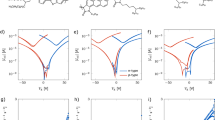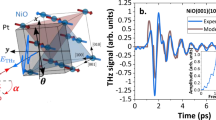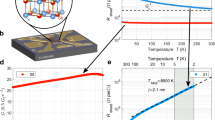Abstract
Polymeric semiconductors exhibit exceptionally long spin lifetimes, and recently observed micrometre spin diffusion lengths in conjugated polymers demonstrate the potential for organic spintronics devices. Weak spin–orbit and hyperfine interactions lie at the origin of their long spin lifetimes, but the coupling mechanism of a spin to its environment remains elusive. Here, we present a systematic study of polaron spin lifetimes in field-effect transistors with high-mobility conjugated polymers as an active layer. We demonstrate how spin relaxation is governed by the charges’ hopping motion at low temperatures, whereas an Elliott–Yafet-like relaxation due to a transient localization of the carrier wavefunctions is responsible for spin relaxation at high temperatures. In this regime, charge, spin and structural dynamics are intimately related and depend sensitively on the local conformation of polymer backbones and the crystalline packing of the polymer chains.
This is a preview of subscription content, access via your institution
Access options
Access Nature and 54 other Nature Portfolio journals
Get Nature+, our best-value online-access subscription
$29.99 / 30 days
cancel any time
Subscribe to this journal
Receive 12 print issues and online access
$209.00 per year
only $17.42 per issue
Buy this article
- Purchase on Springer Link
- Instant access to full article PDF
Prices may be subject to local taxes which are calculated during checkout





Similar content being viewed by others
Data availability
The data underlying this publication are available on the University of Cambridge data repository at https://doi.org/10.17863/CAM.34786.
Code availability
The CustomXepr source code is published at https://github.com/OE-FET/CustomXepr.
References
Di, D. et al. High-performance light-emitting diodes based on carbene–metal-amides. Science 356, 159–163 (2017).
Weiss, L. R. et al. Strongly exchange-coupled triplet pairs in an organic semiconductor. Nat. Phys. 13, 176–181 (2017).
Rao, A. & Friend, R. H. Harnessing singlet exciton fission to break the Shockley–Queisser limit. Nat. Rev. Mater. 2, 17063–12 (2017).
Wagemans, W. & Koopmans, B. Spin transport and magnetoresistance in organic semiconductors. Phys. Status Solidi B 248, 1029–1041 (2011).
Wohlgenannt, M. Organic magnetoresistance and spin diffusion in organic semiconductor thin film devices. Phys. Status Solidi Rapid. Res. Lett. 6, 229–242 (2012).
Watanabe, S. et al. Polaron spin current transport in organic semiconductors. Nat. Phys. 10, 308–313 (2014).
Wang, S.-J. et al. Long spin diffusion lengths in doped conjugated polymers due to enhanced exchange coupling. Nat. Electron. 2, 98–107 (2019).
Ando, K., Watanabe, S., Mooser, S., Saitoh, E. & Sirringhaus, H. Solution-processed organic spin–charge converter. Nat. Mater. 12, 622–627 (2013).
Sun, D. et al. Inverse spin Hall effect from pulsed spin current in organic semiconductors with tunable spin–orbit coupling. Nat. Mater. 15, 863–869 (2016).
Sanvito, S. The rise of spinterface science. Nat. Phys. 6, 562–564 (2010).
Shao, M. et al. The isotopic effects of deuteration on optoelectronic properties of conducting polymers. Nat. Commun. 5, 3180 (2014).
Steyrleuthner, R. et al. Impact of morphology on polaron delocalization in a semicrystalline conjugated polymer. Phys. Chem. Chem. Phys. 19, 3627–3639 (2017).
Schott, S. et al. Tuning the effective spin–orbit coupling in molecular semiconductors. Nat. Commun. 8, 15200 (2017).
McNellis, E. R., Schott, S., Sirringhaus, H. & Sinova, J. Molecular tuning of the magnetic response in organic semiconductors. Phys. Rev. Mater. 2, 074405 (2018).
Matsui, H., Hasegawa, T., Tokura, Y., Hiraoka, M. & Yamada, T. Polaron motional narrowing of electron spin resonance in organic field-effect transistors. Phys. Rev. Lett. 100, 126601 (2008).
Matsui, H., Mishchenko, A. S. & Hasegawa, T. Distribution of localized states from fine analysis of electron spin resonance spectra in organic transistors. Phys. Rev. Lett. 104, 056602 (2010).
Marumoto, K. et al. Microscopic mechanisms behind the high mobility in rubrene single-crystal transistors as revealed by field-induced electron spin resonance. Phys. Rev. B 83, 075302 (2011).
Matsui, H. et al. Correlation between interdomain carrier hopping and apparent mobility in polycrystalline organic transistors as investigated by electron spin resonance. Phys. Rev. B 85, 035308 (2012).
Tsurumi, J. et al. Coexistence of ultra-long spin relaxation time and coherent charge transport in organic single-crystal semiconductors. Nat. Phys. 13, 994–998 (2017).
Harmon, N. J. & Flatté, M. E. Distinguishing spin relaxation mechanisms in organic semiconductors. Phys. Rev. Lett. 110, 176602 (2013).
Yu, Z. G., Ding, F. & Wang, H. Hyperfine interaction and its effects on spin dynamics in organic solids. Phys. Rev. B 87, 205446 (2013).
Yu, Z. G. Spin–orbit coupling, spin relaxation, and spin diffusion in organic solids. Phys. Rev. Lett. 106, 106602 (2011).
Yu, Z. G. Spin–orbit coupling and its effects in organic solids. Phys. Rev. B 85, 115201 (2012).
Yu, Z. G. Microscopic theory of electron spin relaxation in N@C60. Phys. Rev. B 77, 821–826 (2008).
Xiong, Z. H., Wu, D., Valy Vardeny, Z. & Shi, J. Giant magnetoresistance in organic spin-valves. Nature 427, 821–824 (2004).
Pramanik, S. et al. Observation of extremely long spin relaxation times in an organic nanowire spin valve. Nat. Nanotechnol. 2, 216–219 (2007).
Shim, J. H. et al. Large spin diffusion length in an amorphous organic semiconductor. Phys. Rev. Lett. 100, 226603 (2008).
Mooser, S., Cooper, J. F. K., Banger, K. K., Wunderlich, J. & Sirringhaus, H. Spin injection and transport in a solution-processed organic semiconductor at room temperature. Phys. Rev. B 85, 235202 (2012).
Jiang, S. W. et al. Exchange-dominated pure spin current transport in Alq3 molecules. Phys. Rev. Lett. 115, 086601 (2015).
McCamey, D. R. et al. Hyperfine-field-mediated spin beating in electrostatically bound charge carrier pairs. Phys. Rev. Lett. 104, 13–14 (2010).
Nguyen, T. D., Gautam, B. R., Ehrenfreund, E. & Vardeny, Z. V. Magnetoconductance response in unipolar and bipolar organic diodes at ultrasmall fields. Phys. Rev. Lett. 105, 166804 (2010).
Szulczewski, G., Sanvito, S. & Coey, M. A spin of their own. Nat. Mater. 8, 693–695 (2009).
Grünewald, M. et al. Tunneling anisotropic magnetoresistance in organic spin valves. Phys. Rev. B 84, 125208 (2011).
Grünewald, M. et al. Vertical organic spin valves in perpendicular magnetic fields. Phys. Rev. B 88, 085319 (2013).
Wid, O. et al. Investigation of the unidirectional spin heat conveyer effect in a 200 nm thin yttrium iron garnet film. Sci. Rep. 6, 28233 (2016).
Li, L., Lu, N., Liu, M. & Bässler, H. General Einstein relation model in disordered organic semiconductors under quasiequilibrium. Phys. Rev. B 90, 214107 (2014).
Wetzelaer, G. A. H., Koster, L. J. A. & Blom, P. W. M. Validity of the Einstein relation in disordered organic semiconductors. Phys. Rev. Lett. 107, 066605 (2011).
Yu, Z. G. Suppression of the Hanle effect in organic spintronic devices. Phys. Rev. Lett. 111, 016601 (2013).
Venkateshvaran, D. et al. Approaching disorder-free transport in high-mobility conjugated polymers. Nature 515, 384–388 (2014).
Gruber, M. et al. Enabling high-mobility, ambipolar charge-transport in a DPP-benzotriazole copolymer by side-chain engineering. Chem. Sci. 6, 6949–6960 (2015).
Schott, S. et al. Charge-transport anisotropy in a uniaxially aligned diketopyrrolopyrrole-based copolymer. Adv. Mater. 27, 7356–7364 (2015).
Yan, H. et al. A high-mobility electron-transporting polymer for printed transistors. Nature 457, 679–686 (2009).
Abragam, A. The Principles of Nuclear Magnetism (Oxford University Press, 1961).
Redfield, A. G. On the theory of relaxation processes. IBM J. Res. Dev. 1, 19–31 (1957).
Slichter, C. P. Principles of Magnetic Resonance (Springer, 2013).
Mishchenko, A. S., Matsui, H. & Hasegawa, T. Distribution of localized states from fine analysis of electron spin resonance spectra of organic semiconductors: physical meaning and methodology. Phys. Rev. B 85, 085211 (2012).
Baker, W. J., Keevers, T. L., Lupton, J. M., McCamey, D. R. & Boehme, C. Slow hopping and spin dephasing of coulombically bound polaron pairs in an organic semiconductor at room temperature. Phys. Rev. Lett. 108, 267601 (2012).
Zhang, X. et al. Molecular origin of high field-effect mobility in an indacenodithiophene–benzo-thiadiazole copolymer. Nat. Commun. 4, 2238 (2013).
Liu, T. & Troisi, A. Understanding the microscopic origin of the very high charge mobility in PBTTT: tolerance of thermal disorder. Adv. Funct. Mater. 24, 925–933 (2013).
Fornari, R. P. & Troisi, A. Theory of charge hopping along a disordered polymer chain. Phys. Chem. Chem. Phys. 16, 9997–10007 (2014).
Vezie, M. S. et al. Exploring the origin of high optical absorption in conjugated polymers. Nat. Mater. 15, 746–753 (2016).
Kang, K. et al. 2D coherent charge transport in highly ordered conducting polymers doped by solid state diffusion. Nat. Mater. 15, 896–902 (2016).
Fujimoto, R. et al. Molecular doping in organic semiconductors: fully solution-processed, vacuum-free doping with metal–organic complexes in an orthogonal solvent. J. Mater. Chem. C. 5, 12023–12030 (2017).
Marcon, V. et al. Understanding structure–mobility relations for perylene tetracarboxydiimide derivatives. J. Am. Chem. Soc. 131, 11426–11432 (2009).
May, F., Marcon, V., Hansen, M. R., Grozema, F. & Andrienko, D. Relationship between supramolecular assembly and charge-carrier mobility in perylenediimide derivatives: the impact of side chains. J. Mater. Chem. 21, 9538–9545 (2011).
Anderson, M. et al. Displacement of polarons by vibrational modes in doped conjugated polymers. Phys. Rev. Mater. 1, 055604–055609 (2017).
McCulloch, I. et al. Liquid-crystalline semiconducting polymers with high charge-carrier mobility. Nat. Mater. 5, 328–333 (2006).
Di Pietro, R. et al. Coulomb enhanced charge transport in semicrystalline polymer semiconductors. Adv. Funct. Mater. 26, 8011–8022 (2016).
Statz, M. et al. On the manifestation of electron–electron interactions in the thermoelectric response of semicrystalline conjugated polymers with low energetic disorder. Commun. Phys. 1, 1319 (2018).
DeLongchamp, D. M. et al. Controlling the orientation of terraced nanoscale ‘ribbons’ of a poly(thiophene) semiconductor. ACS Nano 3, 780–787 (2009).
Wang, C. et al. Microstructural origin of high mobility in high-performance poly(thieno-thiophene) thin-film transistors. Adv. Mater. 22, 697–701 (2010).
Schuettfort, T. et al. Microstructure of polycrystalline pBTTT films: domain mapping and structure formation. ACS Nano 6, 1849–1864 (2012).
Beljonne, D. et al. Optical signature of delocalized polarons in conjugated polymers. Adv. Funct. Mater. 11, 229–234 (2001).
Chew, A. R. et al. Unraveling the effect of conformational and electronic disorder in the charge transport processes of semiconducting polymers. Adv. Funct. Mater. 28, 1804142 (2018).
Fratini, S., Mayou, D. & Ciuchi, S. The transient localization scenario for charge transport in crystalline organic materials. Adv. Funct. Mater. 26, 2292–2315 (2016).
Lemaur, V. et al. On the supramolecular packing of high electron mobility naphthalene diimide copolymers: the perfect registry of asymmetric branched alkyl side chains. Macromolecules 46, 8171–8178 (2013).
Kronemeijer, A. J. et al. Two-dimensional carrier distribution in top-gate polymer field-effect transistors: correlation between width of density of localized states and Urbach energy. Adv. Mater. 26, 728–733 (2014).
Nikolka, M. et al. High operational and environmental stability of high-mobility conjugated polymer field-effect transistors through the use of molecular additives. Nat. Mater. 16, 356–362 (2016).
Lu, G. et al. Moderate doping leads to high performance of semiconductor/insulator polymer blend transistors. Nat. Commun. 4, 1588 (2013).
Acknowledgements
Funding from ERC Synergy grant SC2 (no. 610115), the Alexander von Humboldt Foundation and the Transregional Collaborative Research Center (SFB/TRR) 173 SPIN+X is acknowledged. S.S. thanks the Winton Programme for the Physics of Sustainability and the Engineering and Physical Sciences Research Council (EPSRC) for funding as well as Z.-G. Yu for discussions, R. Chakalov for assistance with sample fabrication and S.-i. Kuroda, H. Tanaka and S. Watanabe for training and discussions. U.C. is a recipient of a DFG-funded position through the Excellence Initiative by the Graduate School Materials Science in Mainz (GSC 266). The work in Mons was supported by the European Commission/Région Wallonne (FEDER–BIORGEL project), the Consortium des Équipements de Calcul Intensif (CÉCI), funded by the Fonds National de la Recherche Scientifique (FRS-FNRS) under grant no. 2.5020.11 as well as the Tier-1 supercomputer of the Fédération Wallonie-Bruxelles, infrastructure funded by the Walloon Region under grant agreement n1117545, and FRS-FNRS. D.B. is FNRS Research Director. This research was undertaken in part on the SAXS/WAXS beamline at the Australian Synchrotron, part of ANSTO.
Author information
Authors and Affiliations
Contributions
S.S. fabricated the FI-ESR devices and carried out the ESR experiments and analyses. R.L.C. performed the Raman measurements. R.D.P. developed the methods to tune the crystallinity of p(NDI2O–T2) and helped with both the fabrication of samples and the interpretation of results. X.J. and C.R.M. carried out the GIWAXS measurements and analysed the GIWAXS data. I.R. carried out and analysed the Hall effect measurements. U.C. and E.R.M. performed the calculation and analyses of spin admixtures. A.Melnyk and D.A. carried out the simulations of dynamic disorder in IDTBT. Y.O., V.L. and D.B. performed the calculations of torsional autocorrelation functions and intra-chain spin density dynamics. C.J., M.L., A.Marks and I.M. synthesized the materials. S.S. and H.S. wrote the manuscript with input from all authors. H.S. and J.S. supervised the project. All authors discussed the results.
Corresponding author
Ethics declarations
Competing interests
The authors declare no competing interests.
Additional information
Journal peer review information: Nature Physics thanks Z. Valy Vardeny, Zhi-Gang Yu and the other, anonymous, reviewer(s) for their contribution to the peer review of this work.
Publisher’s note: Springer Nature remains neutral with regard to jurisdictional claims in published maps and institutional affiliations.
Supplementary information
Supplementary Information
16 Figures, 1 Table, 60 References.
Rights and permissions
About this article
Cite this article
Schott, S., Chopra, U., Lemaur, V. et al. Polaron spin dynamics in high-mobility polymeric semiconductors. Nat. Phys. 15, 814–822 (2019). https://doi.org/10.1038/s41567-019-0538-0
Received:
Accepted:
Published:
Issue Date:
DOI: https://doi.org/10.1038/s41567-019-0538-0
This article is cited by
-
Vibronic effects on the quantum tunnelling of magnetisation in Kramers single-molecule magnets
Nature Communications (2024)
-
Spin relaxation of electron and hole polarons in ambipolar conjugated polymers
Nature Communications (2024)
-
Molecular design for enhanced spin transport in molecular semiconductors
Nano Research (2023)
-
High-mobility semiconducting polymers with different spin ground states
Nature Communications (2022)
-
Dynamic self-stabilization in the electronic and nanomechanical properties of an organic polymer semiconductor
Nature Communications (2022)



